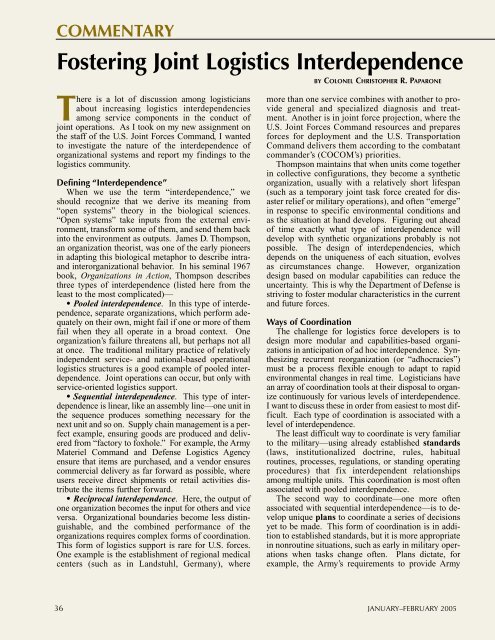Supporting the First Stryker Brigade in Iraq - Army Logistics ...
Supporting the First Stryker Brigade in Iraq - Army Logistics ...
Supporting the First Stryker Brigade in Iraq - Army Logistics ...
You also want an ePaper? Increase the reach of your titles
YUMPU automatically turns print PDFs into web optimized ePapers that Google loves.
COMMENTARY<br />
Foster<strong>in</strong>g Jo<strong>in</strong>t <strong>Logistics</strong> Interdependence<br />
There is a lot of discussion among logisticians<br />
about <strong>in</strong>creas<strong>in</strong>g logistics <strong>in</strong>terdependencies<br />
among service components <strong>in</strong> <strong>the</strong> conduct of<br />
jo<strong>in</strong>t operations. As I took on my new assignment on<br />
<strong>the</strong> staff of <strong>the</strong> U.S. Jo<strong>in</strong>t Forces Command, I wanted<br />
to <strong>in</strong>vestigate <strong>the</strong> nature of <strong>the</strong> <strong>in</strong>terdependence of<br />
organizational systems and report my f<strong>in</strong>d<strong>in</strong>gs to <strong>the</strong><br />
logistics community.<br />
Def<strong>in</strong><strong>in</strong>g “Interdependence”<br />
When we use <strong>the</strong> term “<strong>in</strong>terdependence,” we<br />
should recognize that we derive its mean<strong>in</strong>g from<br />
“open systems” <strong>the</strong>ory <strong>in</strong> <strong>the</strong> biological sciences.<br />
“Open systems” take <strong>in</strong>puts from <strong>the</strong> external environment,<br />
transform some of <strong>the</strong>m, and send <strong>the</strong>m back<br />
<strong>in</strong>to <strong>the</strong> environment as outputs. James D. Thompson,<br />
an organization <strong>the</strong>orist, was one of <strong>the</strong> early pioneers<br />
<strong>in</strong> adapt<strong>in</strong>g this biological metaphor to describe <strong>in</strong>traand<br />
<strong>in</strong>terorganizational behavior. In his sem<strong>in</strong>al 1967<br />
book, Organizations <strong>in</strong> Action, Thompson describes<br />
three types of <strong>in</strong>terdependence (listed here from <strong>the</strong><br />
least to <strong>the</strong> most complicated)—<br />
• Pooled <strong>in</strong>terdependence. In this type of <strong>in</strong>terdependence,<br />
separate organizations, which perform adequately<br />
on <strong>the</strong>ir own, might fail if one or more of <strong>the</strong>m<br />
fail when <strong>the</strong>y all operate <strong>in</strong> a broad context. One<br />
organization’s failure threatens all, but perhaps not all<br />
at once. The traditional military practice of relatively<br />
<strong>in</strong>dependent service- and national-based operational<br />
logistics structures is a good example of pooled <strong>in</strong>terdependence.<br />
Jo<strong>in</strong>t operations can occur, but only with<br />
service-oriented logistics support.<br />
• Sequential <strong>in</strong>terdependence. This type of <strong>in</strong>terdependence<br />
is l<strong>in</strong>ear, like an assembly l<strong>in</strong>e—one unit <strong>in</strong><br />
<strong>the</strong> sequence produces someth<strong>in</strong>g necessary for <strong>the</strong><br />
next unit and so on. Supply cha<strong>in</strong> management is a perfect<br />
example, ensur<strong>in</strong>g goods are produced and delivered<br />
from “factory to foxhole.” For example, <strong>the</strong> <strong>Army</strong><br />
Materiel Command and Defense <strong>Logistics</strong> Agency<br />
ensure that items are purchased, and a vendor ensures<br />
commercial delivery as far forward as possible, where<br />
users receive direct shipments or retail activities distribute<br />
<strong>the</strong> items fur<strong>the</strong>r forward.<br />
• Reciprocal <strong>in</strong>terdependence. Here, <strong>the</strong> output of<br />
one organization becomes <strong>the</strong> <strong>in</strong>put for o<strong>the</strong>rs and vice<br />
versa. Organizational boundaries become less dist<strong>in</strong>guishable,<br />
and <strong>the</strong> comb<strong>in</strong>ed performance of <strong>the</strong><br />
organizations requires complex forms of coord<strong>in</strong>ation.<br />
This form of logistics support is rare for U.S. forces.<br />
One example is <strong>the</strong> establishment of regional medical<br />
centers (such as <strong>in</strong> Landstuhl, Germany), where<br />
36<br />
BY COLONEL CHRISTOPHER R. PAPARONE<br />
more than one service comb<strong>in</strong>es with ano<strong>the</strong>r to provide<br />
general and specialized diagnosis and treatment.<br />
Ano<strong>the</strong>r is <strong>in</strong> jo<strong>in</strong>t force projection, where <strong>the</strong><br />
U.S. Jo<strong>in</strong>t Forces Command resources and prepares<br />
forces for deployment and <strong>the</strong> U.S. Transportation<br />
Command delivers <strong>the</strong>m accord<strong>in</strong>g to <strong>the</strong> combatant<br />
commander’s (COCOM’s) priorities.<br />
Thompson ma<strong>in</strong>ta<strong>in</strong>s that when units come toge<strong>the</strong>r<br />
<strong>in</strong> collective configurations, <strong>the</strong>y become a syn<strong>the</strong>tic<br />
organization, usually with a relatively short lifespan<br />
(such as a temporary jo<strong>in</strong>t task force created for disaster<br />
relief or military operations), and often “emerge”<br />
<strong>in</strong> response to specific environmental conditions and<br />
as <strong>the</strong> situation at hand develops. Figur<strong>in</strong>g out ahead<br />
of time exactly what type of <strong>in</strong>terdependence will<br />
develop with syn<strong>the</strong>tic organizations probably is not<br />
possible. The design of <strong>in</strong>terdependencies, which<br />
depends on <strong>the</strong> uniqueness of each situation, evolves<br />
as circumstances change. However, organization<br />
design based on modular capabilities can reduce <strong>the</strong><br />
uncerta<strong>in</strong>ty. This is why <strong>the</strong> Department of Defense is<br />
striv<strong>in</strong>g to foster modular characteristics <strong>in</strong> <strong>the</strong> current<br />
and future forces.<br />
Ways of Coord<strong>in</strong>ation<br />
The challenge for logistics force developers is to<br />
design more modular and capabilities-based organizations<br />
<strong>in</strong> anticipation of ad hoc <strong>in</strong>terdependence. Syn<strong>the</strong>siz<strong>in</strong>g<br />
recurrent reorganization (or “adhocracies”)<br />
must be a process flexible enough to adapt to rapid<br />
environmental changes <strong>in</strong> real time. Logisticians have<br />
an array of coord<strong>in</strong>ation tools at <strong>the</strong>ir disposal to organize<br />
cont<strong>in</strong>uously for various levels of <strong>in</strong>terdependence.<br />
I want to discuss <strong>the</strong>se <strong>in</strong> order from easiest to most difficult.<br />
Each type of coord<strong>in</strong>ation is associated with a<br />
level of <strong>in</strong>terdependence.<br />
The least difficult way to coord<strong>in</strong>ate is very familiar<br />
to <strong>the</strong> military—us<strong>in</strong>g already established standards<br />
(laws, <strong>in</strong>stitutionalized doctr<strong>in</strong>e, rules, habitual<br />
rout<strong>in</strong>es, processes, regulations, or stand<strong>in</strong>g operat<strong>in</strong>g<br />
procedures) that fix <strong>in</strong>terdependent relationships<br />
among multiple units. This coord<strong>in</strong>ation is most often<br />
associated with pooled <strong>in</strong>terdependence.<br />
The second way to coord<strong>in</strong>ate—one more often<br />
associated with sequential <strong>in</strong>terdependence—is to develop<br />
unique plans to coord<strong>in</strong>ate a series of decisions<br />
yet to be made. This form of coord<strong>in</strong>ation is <strong>in</strong> addition<br />
to established standards, but it is more appropriate<br />
<strong>in</strong> nonrout<strong>in</strong>e situations, such as early <strong>in</strong> military operations<br />
when tasks change often. Plans dictate, for<br />
example, <strong>the</strong> <strong>Army</strong>’s requirements to provide <strong>Army</strong><br />
JANUARY–FEBRUARY 2005







